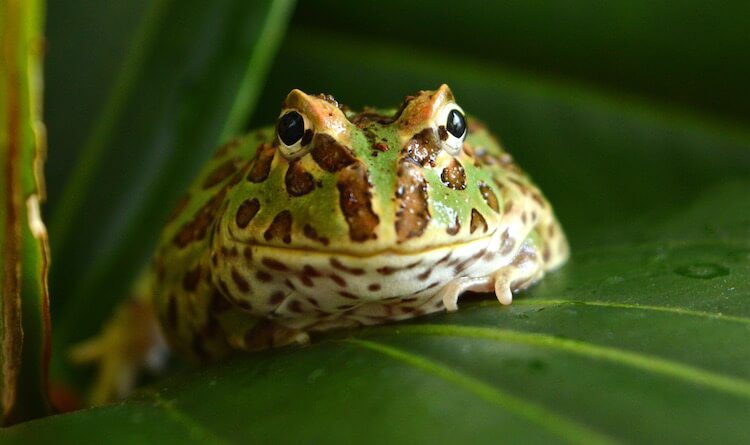Green Horned Frog Care Sheet
Housing
Green Horned Frogs are an inactive species of frog, therefore do not require a large enclosure. However adequate space should be provided for you frog to grow. Green horned frogs get quite big. Glass and plastic enclosures are best suited to Horned frogs as they let the heat escape more quickly than vivariums.
An earth-based substrate like moss, coconut, etc. is the best kind of substrate for their environment.
Your frog’s enclosure should be spot cleaned daily and will require a full clean every 3-4 weeks to prevent the build-up of moisture which can cause bacteria to grow.
Feeding
Juvenile Horned frogs should be fed daily. Ensure their food is coated with a calcium and vitamin D3 supplement 2-3 times a week. Juveniles will eat mealworms, locust, pinkie mice, and waxworms.
Adult Horned frogs will eat larger prey items, but care should be taken to ensure the food is not too big. Do not feed anything larger than the frog’s head. Adults require supplementary calcium and vitamin D3 at least once a week.
Water
All amphibians require fresh water daily. A large water dish should be provided but the water level should be no higher than your frogs height when at rest. Horned frogs are not very able swimmers and usually reside in shallow water.
Like most amphibians horned frogs will soak up water through their skin, and since their water dish is used as a main place to defecate extra care should be taken to change the water when it has been soiled.
Humidity
All species of Horned Frog require humidity. Ornate Horned Frogs need relatively higher humidity than Cranwell’s Horned Frogs. A light misting of the enclosure should be sufficient to keep the enclosure humid, ensuring the substrate is damp and not waterlogged.
Lighting
The ideal temperature for your Horned Frog is a temperature gradient of 24-28c. This can be achieved by placing a heat bulb in an upright position on the back of the tank (outside). Placing the heat mat underneath the enclosure can cause the substrate to dry too quickly. The heat mat should be controlled using a thermostat to prevent overheating.
The temperature within the enclosure can be monitored using a high-quality thermometer. A small UVB tube light can be provided within the enclosure but is not necessary. If the presence of UVB is unavailable, extra care should be taken to ensure your frogs food is coated with supplements to prevent lack of calcium.
UVB should not be used when housing Albino Horned Frogs as these are more sensitive to light and may cause blindness (talk to shop assistants for more help with Albino Species).
Hibernation
Hibernation is not required for captive Horned Frogs but may occur if the temperatures in within the enclosure drop below 24c. Your frog will create a cocoon from old skin to help keep moisture in during the colder months. If your frog appears to be estivating you should not feed or handle your frog. Fresh water should still be provided daily to prevent the water going stale.
To bring your Horned frog out of estivation the temperatures within the enclosure should be slowly raised over a couple days and a lighting change in moisture will help wake your frog up and bring them back to normal activity.
Decorations
All amphibians require a place to hide. Horned frogs prefer to bury themselves within the substrate. This should be taking into consideration when choosing decorations. Live plants can be used within the enclosure but may become uprooted if your frog buries near them. Ensure the substrate is deep enough for your frog to cover themselves.
For any further information or advice please feel free to ask a staff member in store or contact the store on 01902 494860









